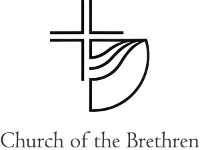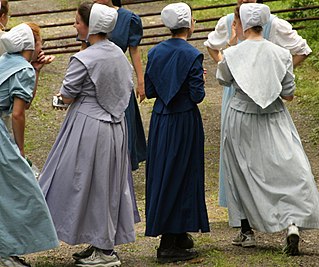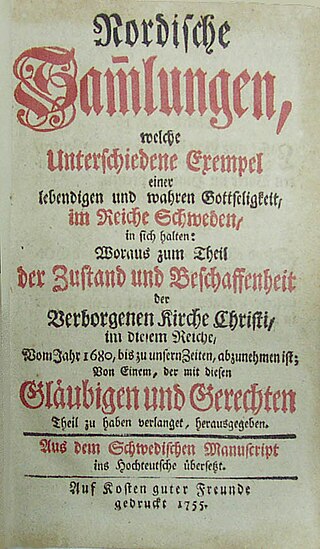
The Church of the Brethren is an Anabaptist Christian denomination in the Schwarzenau Brethren tradition that was organized in 1708 by Alexander Mack in Schwarzenau, Germany during the Radical Pietist revival. The denomination holds the New Testament as its only creed. Historically, the church has taken a strong stance for nonresistance or Christian pacifism—it is one of the three historic peace churches, alongside the Mennonites and Quakers. Distinctive practices include believer's baptism by forward trine immersion; a threefold love feast consisting of feet washing, a fellowship meal, and communion; anointing for healing; and the holy kiss. Its headquarters are in Elgin, Illinois, United States.
Pietism, also known as Pietistic Lutheranism, is a movement within Lutheranism that combines its emphasis on biblical doctrine with an emphasis on individual piety and living a holy Christian life.

An agape feast or lovefeast is a term used for various communal meals shared among Christians. The name comes from the Greek word ἀγάπη (agape), which implies love in the sense of brotherly or familial affection.

The Old German Baptist Brethren (OGBB) is a Schwarzenau Brethren denomination of Anabaptist Christianity.

The Schwarzenau Brethren, the German Baptist Brethren, Dunkers, Dunkard Brethren, Tunkers, or sometimes simply called the German Baptists, are an Anabaptist group that dissented from Roman Catholic, Lutheran and Reformed European state churches during the 17th and 18th centuries. German Baptist Brethren emerged in some German-speaking states in western and southwestern parts of the Holy Roman Empire as a result of the Radical Pietist revival movement of the late 17th and early 18th centuries, where people began to read and study their Bibles on their own- rather than just being told what to believe and do.

The Church of God (New Dunkers) was a religious group that was formed in 1848 by dissidents of the Schwarzenau Brethren (now known as Church of the Brethren).

The Dunkard Brethren Church is a Conservative Anabaptist denomination of the Schwarzenau Brethren tradition, which organized in 1926 when they withdrew from the Church of the Brethren in the United States.

The River Brethren are a group of historically related Anabaptist Christian denominations originating in 1770, during the Radical Pietist movement among German colonists in Pennsylvania. In the 17th century, Mennonite refugees from Switzerland had settled their homes near the Susquehanna River in the northeastern United States.

The Church of the Lutheran Brethren of America (CLBA) is a Lutheran denomination of Christians rooted in a Pietist Lutheran spiritual awakening at the turn of the 20th century.

The Amana Colonies are seven villages on 26,000 acres (110 km2) located in Iowa County in east-central Iowa, United States: Amana, East Amana, High Amana, Middle Amana, South Amana, West Amana, and Homestead. The villages were built and settled by German Radical Pietists, who were persecuted in their homeland by the German state government and the Lutheran Church. Calling themselves the True Inspiration Congregations, they first settled in New York near Buffalo in what is now the town of West Seneca. However, seeking more isolated surroundings, they moved to Iowa in 1856. They lived a communal life until 1932.
Barbara Heinemann Landmann was a spiritual leader with the Community of True Inspiration, for which she served as Werkzeug, or Instrument, in both Europe and the United States. Her sermons and writings are still used during the Community's religious services.
Christian Metz (1794–1867) was born in Germany and immigrated to the United States on October 26, 1842. Once in the U.S., he helped to create a colony for the Community of True Inspiration, a pietist sect. The first was named Ebenezer near what is now Buffalo, New York. In 1855, he relocated to Iowa along with the 1,200-strong congregation and assisted in the founding of the Amana Colonies.
Amana German is a regiolect based on West Central German that is still spoken by several hundred people in the Amana Colonies in Iowa.

Radical Pietism are those Christian churches who decided to break with denominational Lutheranism in order to emphasize certain teachings regarding holy living. Radical Pietists contrast with Church Pietists, who chose to remain within their Lutheran denominational settings. Radical Pietists distinguish between true and false Christianity and hold that the latter is represented by established churches. They separated from established churches to form their own Christian denominations.

Alexander Mack was a German clergyman and the leader and first minister of the Schwarzenau Brethren in the Schwarzenau, Wittgenstein, community of modern-day Bad Berleburg, North Rhine-Westphalia, Germany. Mack founded the Brethren along with seven other Radical Pietists in Schwarzenau in 1708. Mack and the rest of the early Brethren emigrated to the United States in the mid-18th century, where he continued to minister to the Brethren community until his death.

The Old Brethren German Baptists, also called Leedyites, are the most conservative group of Schwarzenau Brethren. They live in Indiana and Missouri.
The Ebenezer Colonies was a settlement founded by the Community of True Inspiration in what is now the town of West Seneca, New York. A congregation of Inspirationists emigrated to the site from Germany in 1843. The congregation began to relocate to Iowa in 1855 and the settlement's land was eventually abandoned and sold.

The Old German Baptist Brethren, New Conference is a church belonging to the Schwarzenau Brethren tradition of Anabaptist Christianity. It formed in 2009 as a result of a split among the Old German Baptist Brethren.

The Old Brethren Church is a Schwarzenau Brethren denomination in the Anabaptist tradition of Christianity. They are a believer's church made up of those who voluntarily choose to follow Jesus as His disciples, and are baptized at this time, during their teen or adult years.
Noah Troyer, was an Amish Mennonite farmer and "sleeping preacher," who preached while in a state of trance.







